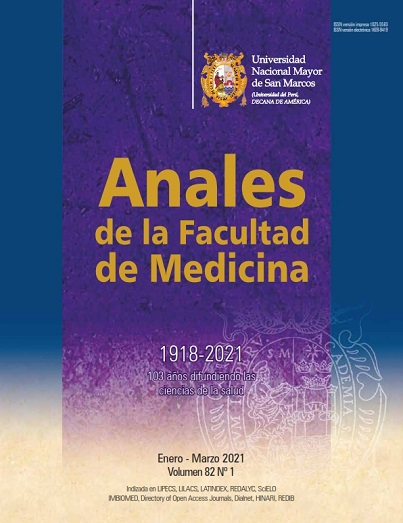Clinical, epidemiological and pathological characteristics of lymphomas in patients from the National Institute of Child Health of Breña - Peru, 2015-2019
DOI:
https://doi.org/10.15381/anales.v82i1.19362Keywords:
Lymphoma, non-Hodgkin´s lymphoma, pediatrics, morbidity, anemia, fever, LymphadenopathyAbstract
Objective. To determine the clinical, epidemiological and pathological characteristics of lymphomas in patients of the National Institute of Child Health Breña between 2015-2019. Methods. A quantitative, observational, crosssectional, descriptive and retrospective study was carried out; corresponding to pediatric patients diagnosed with lymphoma between 2015 and 2019. The SPSS v24 program was used for the analysis. The quantitative variables were expressed in measures of central tendency and the qualitative ones in absolute and relative frequencies. Results. 43 cases were included, the average age was 7.2 years (1a – 16a), 72.1% (n = 31) were male. Among the most frequent symptoms are fever 51.2% (n = 22), weight loss 41.9% (n = 18) and fatigue 20.9% (n = 9) and among the prevalent signs, lymphadenopathy 83.7% (n = 36) and abdominal mass with 14% (n = 6). The most frequent location was the lymph node type with 69.8% (n = 30). Anemia occurred in 58.1% (n = 25). According to the pathological diagnosis, 20 (48.8%) cases were Hodgkin’s Lymphoma (HL) and 23 (51.2%) were non-Hodgkin’s (NHL); the most frequent types being B lymphoblastic lymphoma with 25.6% (n = 11), followed by mixed cellularity LH with 20.9% (n = 9). The most frequent lymphoma in preschool stage was mixed cellularity LH with 31.3% (n = 5), while in school stage B lymphoblastic lymphoma with 25.9% (n = 7). Conclusions. In pediatric patients, lymphoma mainly affects the male sex, presenting fever, weight loss, lymphadenopathy, abdominal tumor and anemia. B lymphoblastic lymphoma was the most frequent; these clinical characteristics are similar to
those reported worldwide.
Downloads
Published
Issue
Section
License
Copyright (c) 2021 Anales de la Facultad de Medicina

This work is licensed under a Creative Commons Attribution-NonCommercial-ShareAlike 4.0 International License.
Those authors who have publications with this magazine accept the following terms:
- Authors will retain their copyrights and guarantee the journal the right of first publication of their work, which will be simultaneously subject to Creative Commons Attribution License that allows third parties to share the work as long as its author and its first publication this magazine are indicated.
- Authors may adopt other non-exclusive licensing agreements for the distribution of the version of the published work (eg, deposit it in an institutional electronic file or publish it in a monographic volume) provided that the initial publication in this magazine is indicated.
- Authors are allowed and recommended to disseminate their work over the Internet (eg: in institutional telematic archives or on their website) before and during the submission process, which It can produce interesting exchanges and increase quotes from the published work. (See El efecto del acceso abierto ).



